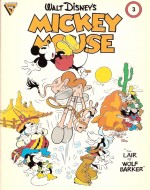
By Floyd Gottfredson (Gladstone)
ISBN: 978-0-94459-903-7
Carl Barks was one of the greatest exponents of comic art the world has ever seen, and he did almost all his work with Disney characters. His work reached and affected untold millions of readers and he all too belatedly won far-reaching recognition. But he wasn’t the first unsung pencil-pushing maestro to turn silver-screen gems into polished gold.
One of his most talented associates, even more influential though certainly far less lauded, was Floyd Gottfredson, a cartooning pathfinder who started out as just another warm body in the company animation factory but became a narrative groundbreaker as influential as Herriman, McCay or Segar.
He took a wild and anarchic animated rodent from slap-stick beginnings, via some of the earliest adventure continuities in comics history as detective, explorer, aviator and cowboy, through to the gently suburbanised sitcom gags of a newly middle-class America that syndicate policy eventually forced upon him. Along the way he produced some of the most engrossing continuities the industry has ever seen.
Arthur Floyd Gottfredson was born in 1905 in Kaysville, Utah, one of eight siblings born to a Mormon family of Danish extraction. Injured in a youthful hunting accident he whiled away a long recuperation drawing and studying cartoon correspondence courses, and by the 1920s had turned professional, selling cartoons and commercial art to local trade magazines and Big City newspaper the Salt Lake City Telegram.
In 1928 he and his wife moved to California, and after a shaky start found work in April 1929 as an in-betweener at the burgeoning Walt Disney Studios. As the Great Depression hit, he was personally asked by Disney to take over the newborn and ailing Mickey Mouse newspaper strip. Gottfredson would plot, draw and often script the strip for the next forty-five-and-a-half years.
Veteran animator Ub Iwerks had initiated the feature but was swiftly replaced by Win Smith. The strip was plagued with problems and young Gottfredson was only supposed to pitch in until a regular creator could be found. His first effort saw print on May 5th 1930 (his 25th birthday) and just kept going; an uninterrupted run over the next five decades. On January 17th 1932, Gottfredson created the first colour Sunday page, which he contiguously handled until 1938, and then almost continually until his death.
At first he did everything, but in 1934 relinquished the scripting role, preferring plotting and illustrating the adventures to playing with dialogue. Collaborating scripters included Ted Osborne, Merrill De Maris, Dick Shaw, Bill Walsh, Roy Williams and Del Connell. He briefly used inkers such as Al Taliaferro, but re-assumed full art chores in 1943.
This delightful compendium collects the very first extended Sunday colour epic which originally ran from January 29th to June 18th 1933. Partially scripted by an unknown writer ‘The Lair of Wolf Barker’ is a rip-roaring comedy western featuring the full repertory cast of Mickey, Minnie, Horace Horsecollar, Clarabelle Cow, and the prototype Goofy, who used to answer to the moniker Dippy Dog.
The gang head west to look after Uncle Mortimer’s sprawling ranch and tumble into a baffling crisis since the cattle are progressively vanishing, with the unsavoury eponymous villain riding roughshod over the assorted characters and stock figures, before his ultimate and well-deserved come-uppance. This is comics on the fly, with plenty of rough and tumble action and fast-packed gags.
Rounding out the book is a selection of early Mickey gags and another landmark Sunday tale. ‘Mickey’s Nephews’ introduced the rascally Morty and Ferdie Fieldmouse in a short romp (September 18th to November 6th 1932) full of waggish behaviour and wicked japery. The sequence was inked by Al Taliaferro, who recalled the story five years later when he and scripter Ted Osborne needed a quick plot for their latest assignment. The job was the new Donald Duck strip and the answer was the infamous ‘Donald’s Nephews’ which introduced Huey, Louie and Dewey to the world…
Gottfredson’s influence on not just the Disney Canon but graphic narrative itself is inestimable: he was one of the first to produce long continuities and “straight†adventures; he pioneered team-ups and invented some of the first “super-villains†in the business. When Disney killed the continuities in 1955 dictating that henceforth strips would only contain one-off gag strips, he adapted easily, working on until retirement in 1975. His last daily appeared on November 15th and the final Sunday strip on September 19th 1976.
Like all Disney creators Gottfredson worked in utter anonymity, but in the 1960s his identity was revealed and the voluble appreciation of his previously unsuspected horde of devotees led to interviews, overviews and public appearances, with effect that subsequent reprinting in books, comics and albums carried a credit for the quiet, reserved master. Floyd Gottfredson died in July 1986.
This huge untapped well of work is only available in tiny snippets like these old Gladstone albums, but hopefully now that Disney own a major comics company some bright spark will realise the potential of the artistic treasures they’ve been sitting on and we’ll soon seen a Gottfredson Mickey Mouse Archives collection.
And since we’re wishing I’d still like that Jonny Seven toy gun I didn’t get in 1969…
© 1987, 1933, 1932 The Walt Disney Company. All Rights Reserved.
